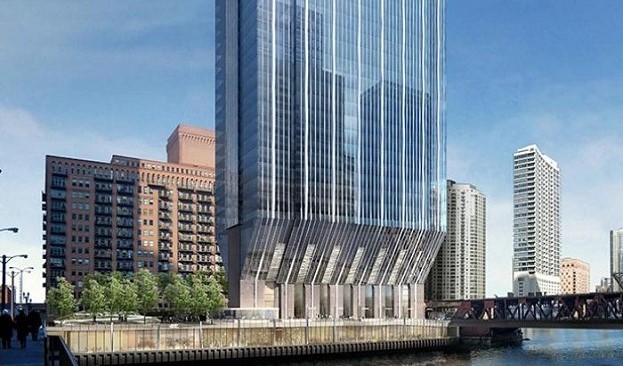 CHICAGO—Amid worries about a possible slowdown, office tenants throughout the US seemed to take a bit of a breather in the first three months of the year. But springtime has dispelled those fears, and year-to-date, tenants have absorbed 21.4 million square feet of space, and in the second quarter absorption outpaced the 12.4 million square feet delivered by developers, according to a report released today by JLL. “I fully anticipated a return to strong leasing activity,” says Julia Georgules , v ice president and associate director of US office research, but this return was not just an ordinary seasonal shift. Almost 50% of new leases for 20,000 square feet or more were expansions, and most of the remainder were unchanged. In addition, the tech economy, which provides much of the office sector's growth, has not slowed. More than 56% of the second quarter's larger tech leases were also expansions. Rents in many markets have approached peak pricing, so JLL expects only a moderate amount of growth during the next 12 to 18 months. But landlords should maintain their leverage in lease negotiations, at least in the near future. “We see signs of an uptick in landlords' leverage in 2017,” says Georgules, especially in secondary markets. These metro areas are “growing full swing in this cycle,” and developers have launched few projects of significance. More surprising is that owners also seem to have an advantage in primary markets with a lot of new construction underway. But even in these cities, such as San Francisco, which now has a vacancy rate of 8.0%, “there is still a section of the market that is functionally obsolete.” That factor puts a limit on tenants' leverage, especially companies that want premier office spaces. According to the JLL report, just ten top markets hold 65% of the supply pipeline. Developers broke ground on another 20 million square feet of space in the second quarter, bringing the total national pipeline to more than 100 million square feet. “Once this new supply is delivered and absorbed, we will see conditions neutralize a bit,” says Georgules.
CHICAGO—Amid worries about a possible slowdown, office tenants throughout the US seemed to take a bit of a breather in the first three months of the year. But springtime has dispelled those fears, and year-to-date, tenants have absorbed 21.4 million square feet of space, and in the second quarter absorption outpaced the 12.4 million square feet delivered by developers, according to a report released today by JLL. “I fully anticipated a return to strong leasing activity,” says Julia Georgules , v ice president and associate director of US office research, but this return was not just an ordinary seasonal shift. Almost 50% of new leases for 20,000 square feet or more were expansions, and most of the remainder were unchanged. In addition, the tech economy, which provides much of the office sector's growth, has not slowed. More than 56% of the second quarter's larger tech leases were also expansions. Rents in many markets have approached peak pricing, so JLL expects only a moderate amount of growth during the next 12 to 18 months. But landlords should maintain their leverage in lease negotiations, at least in the near future. “We see signs of an uptick in landlords' leverage in 2017,” says Georgules, especially in secondary markets. These metro areas are “growing full swing in this cycle,” and developers have launched few projects of significance. More surprising is that owners also seem to have an advantage in primary markets with a lot of new construction underway. But even in these cities, such as San Francisco, which now has a vacancy rate of 8.0%, “there is still a section of the market that is functionally obsolete.” That factor puts a limit on tenants' leverage, especially companies that want premier office spaces. According to the JLL report, just ten top markets hold 65% of the supply pipeline. Developers broke ground on another 20 million square feet of space in the second quarter, bringing the total national pipeline to more than 100 million square feet. “Once this new supply is delivered and absorbed, we will see conditions neutralize a bit,” says Georgules.  Landlords have a good reason to feel confident that tenants will fill these new buildings. Just under 50% of the space is already pre-leased, and some cities have even more impressive numbers, according to Georgules. In Chicago, for example, Hines' 1.1 million square foot development at 444 W. Lake St. is 95% pre-leased, and 150 N. Riverside has tenants for 90% of its 1.2 million square feet. The Chicago area has seen year-to-date 2.3 million square feet of positive net absorption, the most of any in the nation. Tomorrow, GlobeSt.com will use the JLL data to show the remarkable rental rate increases in secondary markets.
Landlords have a good reason to feel confident that tenants will fill these new buildings. Just under 50% of the space is already pre-leased, and some cities have even more impressive numbers, according to Georgules. In Chicago, for example, Hines' 1.1 million square foot development at 444 W. Lake St. is 95% pre-leased, and 150 N. Riverside has tenants for 90% of its 1.2 million square feet. The Chicago area has seen year-to-date 2.3 million square feet of positive net absorption, the most of any in the nation. Tomorrow, GlobeSt.com will use the JLL data to show the remarkable rental rate increases in secondary markets.  CHICAGO—Amid worries about a possible slowdown, office tenants throughout the US seemed to take a bit of a breather in the first three months of the year. But springtime has dispelled those fears, and year-to-date, tenants have absorbed 21.4 million square feet of space, and in the second quarter absorption outpaced the 12.4 million square feet delivered by developers, according to a report released today by JLL. “I fully anticipated a return to strong leasing activity,” says Julia Georgules , v ice president and associate director of US office research, but this return was not just an ordinary seasonal shift. Almost 50% of new leases for 20,000 square feet or more were expansions, and most of the remainder were unchanged. In addition, the tech economy, which provides much of the office sector's growth, has not slowed. More than 56% of the second quarter's larger tech leases were also expansions. Rents in many markets have approached peak pricing, so JLL expects only a moderate amount of growth during the next 12 to 18 months. But landlords should maintain their leverage in lease negotiations, at least in the near future. “We see signs of an uptick in landlords' leverage in 2017,” says Georgules, especially in secondary markets. These metro areas are “growing full swing in this cycle,” and developers have launched few projects of significance. More surprising is that owners also seem to have an advantage in primary markets with a lot of new construction underway. But even in these cities, such as San Francisco, which now has a vacancy rate of 8.0%, “there is still a section of the market that is functionally obsolete.” That factor puts a limit on tenants' leverage, especially companies that want premier office spaces. According to the JLL report, just ten top markets hold 65% of the supply pipeline. Developers broke ground on another 20 million square feet of space in the second quarter, bringing the total national pipeline to more than 100 million square feet. “Once this new supply is delivered and absorbed, we will see conditions neutralize a bit,” says Georgules.
CHICAGO—Amid worries about a possible slowdown, office tenants throughout the US seemed to take a bit of a breather in the first three months of the year. But springtime has dispelled those fears, and year-to-date, tenants have absorbed 21.4 million square feet of space, and in the second quarter absorption outpaced the 12.4 million square feet delivered by developers, according to a report released today by JLL. “I fully anticipated a return to strong leasing activity,” says Julia Georgules , v ice president and associate director of US office research, but this return was not just an ordinary seasonal shift. Almost 50% of new leases for 20,000 square feet or more were expansions, and most of the remainder were unchanged. In addition, the tech economy, which provides much of the office sector's growth, has not slowed. More than 56% of the second quarter's larger tech leases were also expansions. Rents in many markets have approached peak pricing, so JLL expects only a moderate amount of growth during the next 12 to 18 months. But landlords should maintain their leverage in lease negotiations, at least in the near future. “We see signs of an uptick in landlords' leverage in 2017,” says Georgules, especially in secondary markets. These metro areas are “growing full swing in this cycle,” and developers have launched few projects of significance. More surprising is that owners also seem to have an advantage in primary markets with a lot of new construction underway. But even in these cities, such as San Francisco, which now has a vacancy rate of 8.0%, “there is still a section of the market that is functionally obsolete.” That factor puts a limit on tenants' leverage, especially companies that want premier office spaces. According to the JLL report, just ten top markets hold 65% of the supply pipeline. Developers broke ground on another 20 million square feet of space in the second quarter, bringing the total national pipeline to more than 100 million square feet. “Once this new supply is delivered and absorbed, we will see conditions neutralize a bit,” says Georgules.  Landlords have a good reason to feel confident that tenants will fill these new buildings. Just under 50% of the space is already pre-leased, and some cities have even more impressive numbers, according to Georgules. In Chicago, for example, Hines' 1.1 million square foot development at 444 W. Lake St. is 95% pre-leased, and 150 N. Riverside has tenants for 90% of its 1.2 million square feet. The Chicago area has seen year-to-date 2.3 million square feet of positive net absorption, the most of any in the nation. Tomorrow, GlobeSt.com will use the JLL data to show the remarkable rental rate increases in secondary markets.
Landlords have a good reason to feel confident that tenants will fill these new buildings. Just under 50% of the space is already pre-leased, and some cities have even more impressive numbers, according to Georgules. In Chicago, for example, Hines' 1.1 million square foot development at 444 W. Lake St. is 95% pre-leased, and 150 N. Riverside has tenants for 90% of its 1.2 million square feet. The Chicago area has seen year-to-date 2.3 million square feet of positive net absorption, the most of any in the nation. Tomorrow, GlobeSt.com will use the JLL data to show the remarkable rental rate increases in secondary markets.
Want to continue reading?
Become a Free ALM Digital Reader.
Once you are an ALM Digital Member, you’ll receive:
- Breaking commercial real estate news and analysis, on-site and via our newsletters and custom alerts
- Educational webcasts, white papers, and ebooks from industry thought leaders
- Critical coverage of the property casualty insurance and financial advisory markets on our other ALM sites, PropertyCasualty360 and ThinkAdvisor
Already have an account? Sign In Now
*May exclude premium content© 2024 ALM Global, LLC, All Rights Reserved. Request academic re-use from www.copyright.com. All other uses, submit a request to [email protected]. For more information visit Asset & Logo Licensing.








